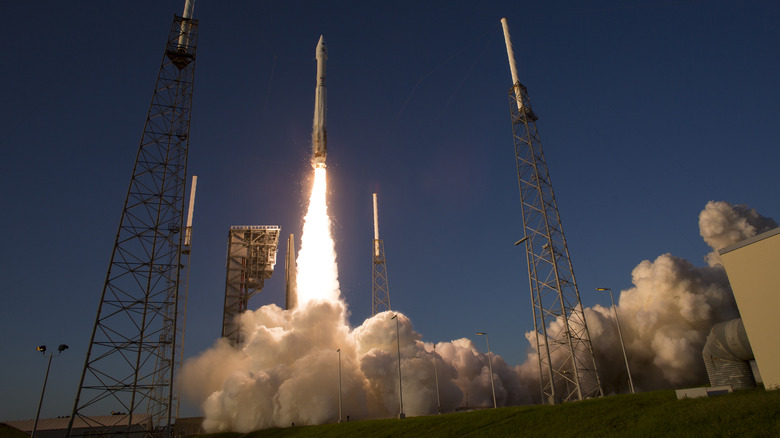NASA's OSIRIS-REx Asteroid Mission Explained
Even if the space race of the 21st century isn't quite as electrifying as the one from the Cold War, it can still inspire big headlines and bigger dreams. A manned mission to Mars remains a tempting prospect (if still beyond our reach), and there's always a return to the moon — per NPR, multiple countries have their eyes on the moon, specifically on its south pole and its possible sources of water.
But human activity in outer space has expanded in the 21st century. On September 8, 2016, NASA launched OSIRIS-REx out of Cape Canaveral. The first American spacecraft of its kind, OSIRIS-REx (an acronym for Origins, Spectral Interpretation, Resource Identification, Security-Regolith Explorer), was part of the agency's New Frontiers Program, designed to target international priorities in space exploration. The first launch of the program, New Horizons in 2006, provided an in-depth study of Pluto; the second, Juno, was launched in 2011 and examined Jupiter. The specific aims for OSIRIS-REx were to land on an asteroid, harvest a sample, and return to Earth on September 24, 2023.
Using Earth's gravity to help slingshot itself toward the targeted asteroid, dubbed Bennu, OSIRIS-REx successfully reached it on December 3, 2018, and collected a sample in October 2020. It embarked on its return journey in 2021 and, as of August 2023, is still on track to safely deliver its cargo to Utah at the target date, after which it will begin a new mission.
OSIRIS-REx's findings could tell us about the origins of life
One may ask why NASA's New Frontiers Program is sending spaceships to dig up pieces of a big space rock before renewing manned visits to the moon and beyond. But there are some fundamental questions about the origins of life on Earth that spacecraft like OSIRIS-REx might help to answer by harvesting asteroid samples. One of these is the origin of our water. According to EurekAlert!, it predates the planet itself and may even predate the sun, and it's thought that asteroids like Bennu are what brought it to Earth. Per The Salt Lake Tribune, Bennu is estimated to be slightly older than Earth and therefore a prime target for such investigations; it's a time capsule of the early solar system.
Bennu is also a carbon-rich asteroid, and carbon is an essential building block of life as we know it. Just as water is theorized to have come from the stars, many scientists believe that asteroids delivered carbon and organic building blocks to Earth. OSIRIS-REx isn't the first mission to harvest samples from an asteroid in the hope of finding such compounds — the Japanese spacecraft Hayabusa2 delivered material taken from the asteroid Ryugu in 2019 (per the BBC). Analysis showed that Ryugu indeed carried organic molecules, though the sample lacked certain ingredients for life. It's anticipated that OSIRIS-REx will deliver a larger sample that can be compared with the findings from Ryugu.
It may help warn against dangerous impacts
There may one day be practical applications for the knowledge that OSIRIS-REx and other asteroid-sampling spaceships can bring back to Earth. The possibility of mining asteroids for valuable natural resources has been discussed, as has using them as fueling stations for future space flights. Such research may also have security applications. Bennu is a large asteroid, 1,600 feet in diameter, and its orbit around the sun crosses Earth's. Notably, its orbit is impacted by the Yarkovsky effect, wherein an object in space emits heat created by the absorption of sunlight and energy on one side. The effect's strength is slight but impactful and may one day push Bennu on a collision course with us. The University of Arizona describes Bennu as having "a relatively high probability of impacting Earth late in the 22nd century."
"Relatively high" in this case still comes to low odds — it's a 0.057% chance that Bennu hits Earth by 2300, according to NASA. But gathering information on the Yarkovsky effect's role in asteroid orbits is among OSIRIS-REx's goals, and that data may help future scientists in forecasting the path of potentially dangerous asteroids and other satellites and in devising ways to deflect them.
OSIRIS-REx won't be returning to Bennu for further study once it drops off its samples. Nor will it ever return to Earth. The plan is to rechristen the ship OSIRIS-APEX (APophis EXplorer) and send it out to observe another asteroid that's come close to Earth: Apophis.


